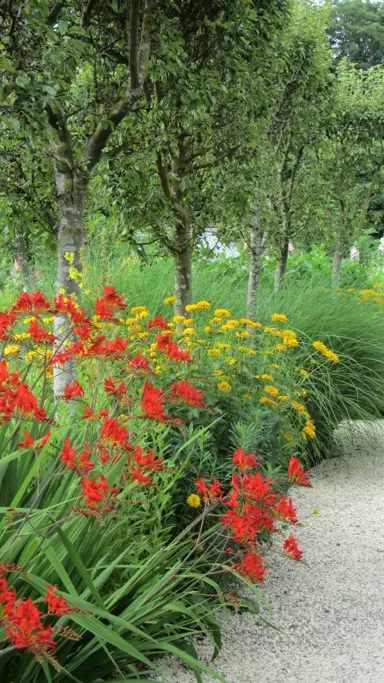
The Plant Company grows, sells, and ships Myoporum plants throughout NZ. We pride ourselves on producing high quality plants and seeing the joy from our customers when they receive them. We do hope you enjoy them and support this NZ business that is passionate about Myoporum plants.
Myoporum laetum, commonly known as Ngaio, is a NZ native tree grown for its lush foliage and showy flowers. It features large, fleshy, green leaves...
Myoporum Coarse Leaf Pink, commonly known as the Boobialla Plant, is a ground covering plant is renowned for its flowers and foliage. Masses of...
Myoporum Fine Leaf Pink, commonly known as the Boobialla Plant, is a ground covering plant is renowned for its flowers and foliage. Masses of small...
Myoporum laetum decumbens, commonly known as prostrate Ngaio, is a quick-growing, NZ native shrub. It has fleshy, dark green leaves and, in summer...
Myoporum parvifolium, commonly known as Creeping Myoporum, is a ground cover plant renowned for its berries and foliage. Masses of small, white...
Myoporum parvifolium purpureum, commonly known as Boobialla, is a ground covering plant that is renowned for its flowers and foliage. Masses of...
Myoporum viscosum, commonly known as Sticky Boobialla or Common Boobialla, is a shrub renowned for its flowers and foliage. Masses of small, white...
Myoporum parvifolium White, commonly known as Creeping Myoporum, is a NZ native ground covering plant. Masses of small, white flowers are borne...
Myoporum Yareena is a ground covering plant is renowned for its flowers and foliage. Masses of small, white flowers are borne through spring and...
Growing colourful NZ-native trees in your garden delivers a vast range of benefits:
We have the largest variety of Ngaio and the right one for your space. Our Myoporum have been selected to thrive in NZ’s climate. We grow and stock only the highest quality plants, sourcing them locally, and from NZ’s leading nurseries. Each plant is packed and transported with extreme care, ensuring it arrives to you in the same condition it was in when it left the nursery. If you are wanting to buy Myoporum, shop with confidence from the best in the industry.
1. What is another name for Myoporum?
There are many common names for Myoporum, depending on the species and region. Some of the most common common names include:
Some specific species of Myoporum also have their own unique common names. For example:
2. Is Myoporum laetum poisonous?
Myoporum laetum is poisonous to livestock, such as horses, cattle, sheep, and pigs. It contains a toxin called ngaione, which can cause liver damage and death. The leaves and fruits of the plant are the most toxic parts. Ngaione is not reported to be toxic to humans, but it can cause skin irritation.
3. Is Myoporum an evergreen?
Myoporum is an evergreen plant. This means that it keeps its leaves year-round, even in winter.
4. How big do myoporum purpurea get?
Myoporum purpurea, also known as creeping boobialla, is a dense, evergreen ground cover that typically grows to be 30-40 cm tall and spreads up to 2 m wide. It has small, purple leaves and produces small white flowers in the spring and summer.
Myoporum purpurea is a popular choice for ground cover because it is low-maintenance and can tolerate a variety of growing conditions, including poor soil, drought, and salt spray. It is also relatively fast-growing, making it a good choice for covering large areas quickly.
5. What is the problem with Myoporum parvifolium?
Myoporum parvifolium, also known as creeping boobialla, is a popular ground cover plant. However, it can be susceptible to a number of problems, including:
6. What is the New Zealand tree Myoporum laetum?
Myoporum laetum, also known as ngaio, is a fast-growing evergreen shrub or small tree native to New Zealand. It can grow up to 10 meters tall and has a wide, spreading crown. The leaves are glossy green and lance-shaped, with small serrations on the edges. The flowers are white with purple spots and are produced in clusters in the spring and summer. The fruit is a small, fleshy drupe that turns red when ripe.
Ngaio is a popular ornamental plant in New Zealand and other parts of the world. It is also used in traditional Maori medicine and has a number of other uses, including:
Ngaio is a relatively low-maintenance plant. It prefers full sun to partial shade and well-drained soil. It is tolerant of drought, salt spray, and poor soil. Ngaio can be pruned to maintain its shape and size, but it is not necessary.
7. What is the sacred tree in New Zealand?
The sacred tree in New Zealand is the kauri (Agathis australis). It is a slow-growing, evergreen tree that can live for thousands of years. Kauri trees are found in the northern part of the North Island of New Zealand, and they are some of the largest trees in the world.
The kauri tree is sacred to the Māori people, who believe that it is the ancestor of all trees. The Māori people use the kauri tree for a variety of purposes, including building materials, carving, and medicine. The kauri tree is also an important part of New Zealand's natural heritage. It is home to a variety of native plants and animals, and it plays an important role in the ecosystem.
One of the most famous kauri trees is Tāne Mahuta, which is located in the Waipoua Forest. Tāne Mahuta is the largest kauri tree in New Zealand, and it is estimated to be over 2,500 years old. It is a popular tourist destination and a sacred place for the Māori people.
Whether you need assistance finding the plant you’re looking for or you simply want to know more about who we are and what we do, we invite you to get in touch with us today. A member of The Plant Company team will get back in touch as soon as possible.


